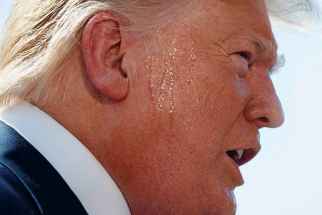Stigmatizing mental illness won’t end the carnage
Read this article for free:
or
Already have an account? Log in here »
To continue reading, please subscribe:
Monthly Digital Subscription
$0 for the first 4 weeks*
- Enjoy unlimited reading on winnipegfreepress.com
- Read the E-Edition, our digital replica newspaper
- Access News Break, our award-winning app
- Play interactive puzzles
*No charge for 4 weeks then price increases to the regular rate of $19.00 plus GST every four weeks. Offer available to new and qualified returning subscribers only. Cancel any time.
Monthly Digital Subscription
$4.75/week*
- Enjoy unlimited reading on winnipegfreepress.com
- Read the E-Edition, our digital replica newspaper
- Access News Break, our award-winning app
- Play interactive puzzles
*Billed as $19 plus GST every four weeks. Cancel any time.
To continue reading, please subscribe:
Add Free Press access to your Brandon Sun subscription for only an additional
$1 for the first 4 weeks*
*Your next subscription payment will increase by $1.00 and you will be charged $16.99 plus GST for four weeks. After four weeks, your payment will increase to $23.99 plus GST every four weeks.
Read unlimited articles for free today:
or
Already have an account? Log in here »
Hey there, time traveller!
This article was published 09/08/2019 (2318 days ago), so information in it may no longer be current.
Deranged. Monster. Evil.
These are among the words politicians employ after a mass murder is carried out by someone with a gun in his hands and hate in his heart. We heard them again this week, following a particularly deadly American weekend that saw 22 people killed at a Walmart in El Paso, Texas, and nine others gunned down outside a bar in Dayton, Ohio.
In the days following the back-to-back massacres that left his nation reeling, U.S. President Donald Trump said, “We are outraged and sickened by this monstrous evil, the cruelty, the hatred, the malice, the bloodshed and the terror,” and added that mass killers are “mentally ill monsters.”
He offered little in the way of solutions.
Rather, Mr. Trump used language that absolves him of responsibility and shifts the blame to something nebulous — such as an “evil” committed by those who are “mentally disturbed.”
Mr. Trump used language that absolves him of responsibility and shifts the blame to something nebulous– such as an “evil” committed by those who are “mentally disturbed.”
Experts have routinely pointed out there is little evidence mental illness is a root cause of mass shootings. Every country on Earth is home to populations of people living with mental illness, yet no other country comes close to the U.S. when it comes to rates of mass shootings. Most people living with a mental illness are not violent; they are more likely to be victims of violent crime than perpetrators. When Mr. Trump characterizes mass murderers as “mentally ill monsters,” all he does is further stigmatize millions of people.
What most mass shooters have in common is not mental illness. It’s that they are, overwhelmingly, young white men who subscribe to violent ideologies and have easy access to guns. One does not have to be mentally ill to be a racist, a misogynist or a white supremacist.
But politicians, Mr. Trump included, do not talk about that. It’s easier to blame “evil” — a word usually preceded by such descriptives as “unspeakable,” “unbelievable” or “incomprehensible” — for mass shootings because then one doesn’t have to do anything at all. It’s evil. A force beyond anyone’s control. As Megan Garber wrote in The Atlantic: “Evil does not want to talk about the National Rifle Association. It makes no room for the uncomfortable details. Evil, used as a talking point, both throws up its hands and washes them.”
What most mass shooters have in common is not mental illness. It’s that they are, overwhelmingly, young white men who subscribe to violent ideologies and have easy access to guns.
And when mental illness is conflated with evil through this kind of rhetoric, it lumps mental illness into that which cannot be named or treated. Mental illness, too, becomes unspeakable, incomprehensible and mysterious. And that’s not only regressive, recalling an era of asylums and lobotomies; it’s irresponsible and dangerous. Mental illness becomes the evil; the person living with mental illness becomes the monster to be feared.
But hate, which is usually what people are really talking about when they talk about evil, is not exceptional or cosmic. It is human. It comes from attitudes and beliefs that are shaped and reinforced over time, passed down through generations. Hate doesn’t always look like a spray of bullets. Sometimes it looks like a comment about “going back home.” Sometimes it looks like the fearful anxiety about an “invasion” of immigrants “stealing our jobs.” Sometimes it looks like children in cages. And at some point in all of that, it can start to look normal.
Mr. Trump says hatred doesn’t belong in America, but hate resides there, as it does elsewhere. And so long as racism, misogyny, white supremacy and homophobia are rebranded as “evil” and left to be sorted out by “thoughts and prayers” rather than policy reform and gun control, it will continue to fester.










